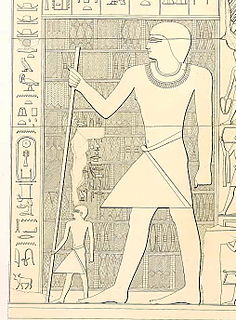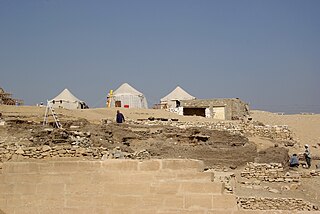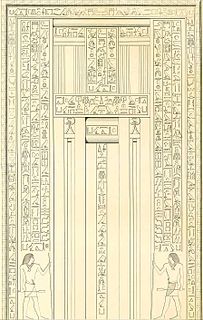Related Research Articles

Djedkare Isesi was a pharaoh, the eighth and penultimate ruler of the Fifth Dynasty of Egypt in the late 25th century to mid-24th century BC, during the Old Kingdom. Djedkare succeeded Menkauhor Kaiu and was in turn succeeded by Unas. His relations to both of these pharaohs remain uncertain, although it is often conjectured that Unas was Djedkare's son, owing to the smooth transition between the two.
Ptahhotep, sometimes known as Ptahhotep I or Ptahhotpe, was an ancient Egyptian vizier during the late 25th century BC and early 24th century BC Fifth Dynasty of Egypt.

Isesi-ankh was an ancient Egyptian high official during the second half of the Fifth Dynasty, in the late 25th to mid 24th century BC. His name means "Isesi lives". He may have been a son of pharaoh Djedkare Isesi and queen Meresankh IV, although this is debated. Isesi-ankh probably lived during the reign of Djedkare Isesi and that of his successor Unas. He was buried in a mastaba tomb in north Saqqara, now ruined.

Rashepses was a vizier from the Fifth Dynasty of Egypt. Rashepses was vizier under Djedkare Isesi. A letter directed to Rashepses has been preserved. This decree is inscribed in his tomb in Saqqara. As vizier he was one of the most important Ancient Egyptian officials. In his tomb are many titles recorded. It seems that he was first overseer of the scribes of the royal documents, overseer of the two granaries and overseer of all royal works. These are all very important titles, making him an influential official at the royal court. At the final stage of his career he became vizier. The vizier title is only preserved in two letters that are copied on the decoration of the tomb. It seems that most of his tomb was finished and after all that, he was promoted.
Nubemhat was an ancient Egyptian queen of the Second Intermediate Period. She was the wife of king Sekhemre Wadjkhaw Sobekemsaf I. She had the title Great Royal Wife and is known from several monuments. A statue with her name and title was found at Kawa in Nubia. She also appears on a stela from Denderah where her daughter, the king's daughter Sobekemheb is mentioned. There also appears the king's son Ameny, son of the queen Haankhes.

The Mastaba of Hesy-re is an ancient Egyptian tomb complex in the great necropolis of Saqqara in Egypt. It is the final resting place of the high official Hesy-re, who served in office during the Third Dynasty under King Djoser (Netjerikhet). His large mastaba is renowned for its well-preserved wall paintings and relief panels made from imported Lebanese cedar, which are today considered masterpieces of Old Kingdom wood carving. The mastaba itself is the earliest example of a painted tomb from the Old Kingdom and the only known example from the Third Dynasty. The tomb was excavated by the Egyptologists Auguste Mariette and James Edward Quibell.
Mehu was an Ancient Egyptian vizier who lived in the Sixth Dynasty, around 2300 BC. The office of the vizier was the most important one at the royal court. Mehu is mainly known from his monumental mastaba at Saqqara, not far away from the Pyramid of Unas.
Kaemtjenent was an ancient Egyptian official under pharaoh Djedkare Isesi in the late Fifth Dynasty, during the Old Kingdom period.

Seshemnefer was an ancient Egyptian official of the Fifth Dynasty, most likely under king Djedkare Isesi. At the end of his career he became vizier, the highest office in Ancient Egypt, second only to the king.
Ptahhotep Desher was an Ancient Egyptian official at the end of the Fifth Dynasty, most likely in office under kings Menkauhor Kaiu and Djedkare Isesi. His main function was that of a vizier. This was the most important office in Ancient Egypt, second only to the king. Ptahhotep also held other titles, such as overseer of the six great houses, overseer of the scribes of the royal documents and overseer of all royal works. These are all important functions, often held by a vizier.

Pehenuikai was an Ancient Egyptian official of the Fifth Dynasty. His main office was that of a vizier, making him to the most important man at the royal court, only second to the king. Beside being vizier, he was also holding many other important titles, such as Overseer of the treasuries, overseer of the scribes of the king's document, overseer of the double granary and overseer of all royal works of the king.
Kay was an Ancient Egyptian official living most likely in the Fifth Dynasty. He is mainly known from his mastaba in Saqqara North. Kay hold a high number of important titles making him the most powerful of his time, only second to the king. His main office was that of a vizier. Beside being vizier, he was also holding many other important titles, such as Overseer of the treasuries, Overseer of Upper Egypt, overseer of the scribes of the king's document, overseer of the six big houses and overseer of all royal works of the king. His mastaba in Saqqara was recorded by Gaston Maspero who assigned to it the number D 19. Kay was bearing 51 titles, making him the vizier with the highest numbers of titles. Kay was the first Egyptian official with the title overseer of the six big houses. The office became one of the most important at the royal court in the later Fifth Dynasty and continued to be so during the subsequent Sixth Dynasty.
Washptah, with the second name Izi, was an ancient Egyptian official in the Fifth Dynasty under king Neferirkare Kakai. His most important title was that of a vizier, making him to the most important official at the royal court, only second to the king. Next to the office of the vizier he hold several other important positions, including overseer of the scribes of the king's document and overseer of all royal works.
Seshathetep, also called Heti, was an ancient Egyptian official at the beginning of the Fifth Dynasty. Seshathetep held many important titles, possibly including that of vizier. With this latter title, he would have been the most important official at the royal court, second only to the king. He also bore the title of king's son of his body, yet it is doubtful that Seshathetep was the real son of a king.
Sekhem-ankh-Ptah was an ancient Egyptian high official who lived during the Old Kingdom period. His main title was that of a vizier, making him to the most important official at the royal court, second only to the king. Other important titles of Sekhem-ankh-Ptah were "Overseer of all royal works" and "Overseer of the scribes of the king's document".
Ptahhotep was an ancient Egyptian official of the Fifth Dynasty, most likely under king Djedkare Isesi. His most important office was that of a vizier, making him to the most important official at the royal court, only second to the king. Next to this important office he held further important titles, such as overseer of the treasuries, overseer of the scribes of the king's document, overseer of the six big houses and overseer of all royal works of the king.
Akhethetep Hemi was an ancient Egyptian official at the end of the Fifth Dynasty, most likely in office under king Unas. His highest title was that of a vizier, making him to the most important official at the royal court, only second to the king. Next to the vizier's titles he was also overseer of the treasuries, overseer of the scribes of the king's document and overseer of the double granary, all these are important position at the royal court.
Ihy was an Ancient Egyptian official of the Fifth Dynasty, in office most likely under king Unas. Ihy was vizier and was therefore the most important official at the royal court only second to the king. Next to the titles of a vizier, he was also overseer of the treasuries, overseer of the scribes of the king's document, overseer of all royal works and overseer of the double granary. These are also important titles, demonstrating his important position at the royal court.
Qar was an official of the Sixth Dynasty of Egypt. Son of Idu, he probably lived and served between Merenre I and Pepy II.
Akhethetep was an ancient Egyptian official mainly known from his mastaba found at Saqqara. Not much is known about Akhethetep. On the reliefs of his mastaba he bears several titles, including overseer of the great house. This was an administrative title of rather unclear function. He had also several religious titles, including priest of Maat and priest of Hathor, lady of Dendera. He had also priestly functions at the funerary cult of different kings and was Priest of Nefer-Djedkare (this is the name of the pyramid of king Djedkare and priest at Nefersut-Unas.
References
- 1 2 Strudwick 1985, pp. 65-66.
- ↑ Strudwick 1985, pp. 66.
- ↑ Hodjash & Berlev 1982, pp. 22.